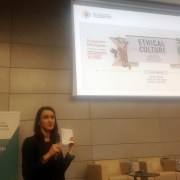Inquiry into Australia’s Banking and Finance Industry
By Dennis Gentilin, founding director of Human Systems Advisory and an adjunct fellow at Macquarie University. He was employed at the National Australia Bank for 16 years.
 As readers of this blog may know, there is currently an inquiry into the banking and finance industry in Australia. Prime Minister Malcolm Turnbull announced The Royal Commission into Misconduct in the Banking, Superannuation and Financial Services Industry in November 2017. Former High Court Judge Kenneth Hayne AC was appointed as the commissioner shortly after the announcement and public hearings commenced earlier this year.
As readers of this blog may know, there is currently an inquiry into the banking and finance industry in Australia. Prime Minister Malcolm Turnbull announced The Royal Commission into Misconduct in the Banking, Superannuation and Financial Services Industry in November 2017. Former High Court Judge Kenneth Hayne AC was appointed as the commissioner shortly after the announcement and public hearings commenced earlier this year.
Although the Prime Minister was not supportive of an inquiry, he eventually relented as the pressure mounted from the public, his political opponents and members of his own party. A string of conduct issues ultimately made his position untenable, the nadir being a money laundering scandal at Australia’s largest bank (this case was settled earlier this week and resulted in a $700 million AUD fine).
The first four weeks of public hearings were extraordinary. A raft of unethical (and, depending on how Commissioner Hayne responds, possibly illegal) conduct was exposed. This ranged from charging fees without rendering any services, to accepting cash bribes in order to rort a program that was designed to introduce new clients to a bank, and misleading the regulator. As can be seen, it has made for some salacious headlines and captivated the public.
More recently, the inquiry turned its attention to commercial lending and, relative to the first four weeks of hearings, there was minimal evidence of egregious wrongdoing. To be sure, the banks did not get a “clean bill of health” and there was evidence of errors in judgment and lack of proper customer care. However much of the so called “wrongdoing” that was exposed is what you would expect from an institution that is in the business of taking risk – things can and do go wrong.
Essentially, the most recent two weeks of evidence confirmed something that has been known for a long time: The wrongdoing within the banking and finance industry that has been the catalyst for the inquiry does not emanate from the corporate lending functions of Australia’s financial institutions. Rather, it has primarily occurred in financial markets (rate rigging), wealth (mis-selling, poor advice, fee for no service and junk insurance) and, to a lesser extent, consumer lending.
Necessarily, one should ask ‘Why’? My view is that this can be explained by one of the core principles that underpins Ethical Systems. The corporate lending functions of Australia’s large financial institutions do not behave more ethically because there are less “rogues” employed within them. Rather, they behave more ethically because of the features of the system within which corporate bankers operate.
What are some of these features? Based on my personal experience, I offer three hypotheses below, all of which need to be proven
First of all, corporate lending involves larger, less frequent transactions that are more heavily scrutinised and examined. When deals become complex or riskier, the credit function of a bank becomes involved and provides a second set of eyes, acting as a proxy audit function. This level of oversight is necessitated by the amount of risk inherent in these transactions, as evidenced by the capital regulators require institutions to hold in support of their corporate lending activities.
Secondly, the incentive schemes for corporate bankers have differed from those that have applied to financial advisers and dealers in financial markets. The latter have historically had a lucrative “at risk” (or bonus) component. Access to this has largely been determined by the ability to generate sales and revenue. The bonuses available to corporate bankers have tended to be more modest and there is a heavier focus on risk (not just sales) when determining incentive outcomes.
Finally, given the nature of the transactions they are executing, corporate bankers build deeper, long-term relationships with their clients. If a corporate client fails, it inevitably results in fractured relationships, reputational damage and significant financial loss. Corporate bankers are therefore committed to the success of their clients as they carry the burden associated with any loss heavily. They have no choice but to take their fiduciary responsibilities seriously.
As mentioned, these are just hypotheses and the list is far from conclusive. Suffice to say, the best way to develop an appreciation for the features of a system that is incubating (un)ethical conduct is by assessing it often and embracing experimentation. Doing this provides evidence that can be used to confirm or reject some of these hypotheses and, by extension, provide guidance on how to respond.
And although the last two weeks of the inquiry have revealed little wrongdoing, this doesn’t mean they have been any less instructive. When a systems approach to addressing conduct issues is adopted, there is just as much insight to be gained from the sectors of the industry that have a clean as opposed to a chequered ethical scorecard. These insights can not only help explain the disparate ethical outcomes, but also help inform the content of the recommendations that are due to be handed down early next year.







